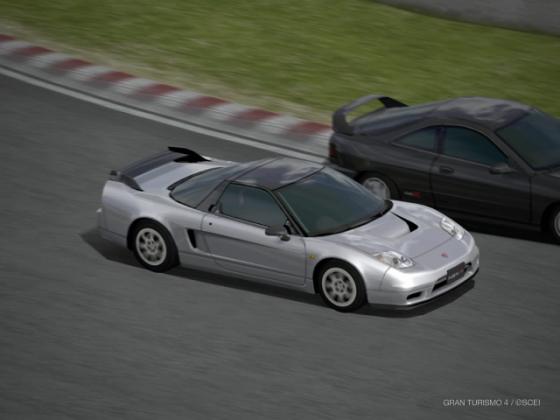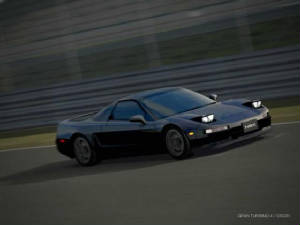|
SPEX
All specs, prices, and testing below currently features type S Zero models.
Year: 1997
Type: 2-door roadster
Class: sports car
Country: Japan
Host: GT1, 2, 3, 4, & 5
Price: 98,570 (GT2) // Prize worth = ? (GT3) // 46,285
(GT4 used lot)
Length: 174.4" // Width: 71.25" // Height: 45.7"
Wheelbase: 99.6"
Overhang:
6' 3.75"
Track: 59.4" [F] 60.2" [R]
Ground Clearance:
Weight: 2,799 pounds
Layout: mid engine / rear drive
Tires:
215/45ZR-16 [F] 245/40ZR-17 [R]
Suspension: double wishbone, coils, anti-roll bars, tube shocks
Brakes: vented discs + vaccum Assist
Engine: 3.2 liter DOHC V6
Aspiration: normal
Fuel System: PGM-Fi
(multi-point fuel-injection)
Valves / Cyl: 4
Compression: 10.2:1
Bore X Stroke: 3.54 x 3.07"
Tested HP: ```288 @ 7,200 rpm (GT2)
Tstd Torque: 233 @ 5,400
rpm (GT2)
Final BHP:`` 284 @ 7,300 rpm(GT4)
Fnl Torque: 230 @ 5,300 rpm (GT4)
`````````````````````GT2````````````````````GT4
Pounds
/ HP: 9.71
9.85
Hp per Liter: 90.6
89.3
Credits / HP: 342.25 173.54
GT2
Redline: 7,500 // Rev Lmit: 8,000
Transmission: 6-Speed Manual
* All track testing performed for Type S Zero models
````````````````````````GT2`````````````````````````````````````GT4
0-60 mph: 5.213
seconds
5.166 seconds
0-100mph: 12.611 seconds
11.900 seconds
0-150mph: ``no test
30.030 seconds
400 M: 13.736 @ 105
mph 13.522 @ 107 mph
1 KM: 24.476 @ 138
mph 24.436 @ 138 mph
100-0 mph: 3.739 seconds````````````````3.97 seconds
Test Track: 1:36.361``````````````````````````2:13.505
Top Gear RPM at 60 mph: 2,800
Top Speed at Redline
1st: 44
mph
2nd: 72 mph
3rd: 100 mph
4th: 127 mph
5th: 158 mph
6th: 181.13 mph @ 7,350 rpm (GT2)
````````178.07 mph @ 7,200 rpm(GT4)
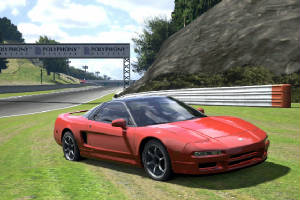
|
| A '91 NSX (non Type S) |
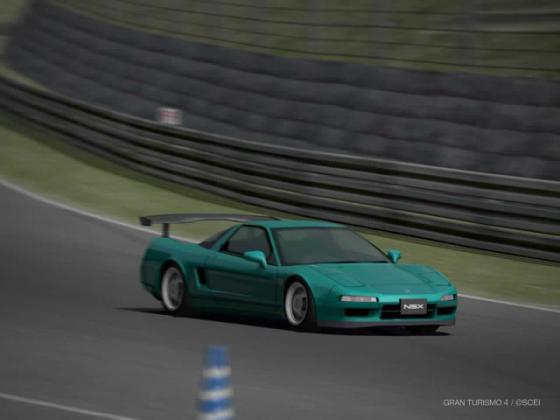
----------------------EXTERIOR / HISTORY---------------------
Here's my next review: the Acura/Honda NSX. Sorry, it's been long overdue. I attempted
to write about this beautifully sleek car almost a year ago but the words just weren't there. Never have I had a case
of writer's block like I did with the NSX. Good thing I'm not trying to impress any editors.
Top-line models found
in GT1, GT2, and GT3 (NTSC / America) were the Type S and Type S Zero. Actually, there is no such thing as the Acura
NSX Type S or Type S Zero. In real-life, these were models available in Japan only, which
means there should be a Honda NSX Type S and Type S Zero in those three games. But these cars first
appeared as Acuras; hence that's why this review focuses on them as Acuras. Only in GT4 does PD get it right--and
we can only find Honda NSX Type S and Type S Zeros in this game.
There are several versions of the NSX in GT1, and
in GT2 there are even more to choose from: a total of fourteen--including four hidden cars, like the
'92 Honda NSX and NSX type R. These cars are hidden in the NTSC version, but I believe they're available for Asian versions
of GT2. It seems all the dealer-bought cars look the same, except the '91 with its black T-top. So why are there NSXes from
'91? From '93? '97? Type S? Type S Zero? Type R? It's confusing. I'll admit I don't fully get it. It's not like
there's a complex lineage to follow here like there is with the Skyline, Camaro, or Z-car family. Compared to these other
cars, the NSX is still fairly young...I don't think there are enough differences in all the dealer's cars to justify devoting
so much memory to them, but whatever.
Of course, all of these models carry different options so far as real-life creature
comforts go. The Type S and Type S Zero are the sportier and sportiest versions of the NSX. This means nothing to us gamers...except
for a difference in weight, and sometimes subtle differences in stock suspension tuning and physics from model to
model. The real-life Type S zero, for instance eschewed air-conditioning, radio & sound system, some soundproofing,
and a navigation system, in order to "zero" in on its 2,799 pound curb weight. But the heavier
models usually had all this stuff installed, them being luxurious cars as well as sports cars.
My bitch isn't
with the NSX and all its versions per se...I'm just really pissed I still haven't got a Boss 302 Mustang in any
of versions of Gran Turismo after all this time. There aren't enough varieties of Mustang (and there aren't enough of
other famous cars like 5.0 3rd-gen Mustangs, Volkswagen Beetles, no Thunderbirds, no Mazda RX-3....) yet there's multiple
versions of NSX. Why????
Anyways, in this review I'll try and touch on all the variations of NSX eventually. But the main one to focus
on is our beloved King: the '97 Honda NSX Type S Zero, a special car with a much shorter production
run than any "regular" NSX. All hail and bow if you feel worthy. Although the NSX type R winds up being lighter (with
a better power-to-weight ratio) than the Type S Zero, the Type R doesn't appear in all four GT games...well, it's not
in the NTSC American versions, anyway. I might wind up someday writing about the Type R we can win in GT4, though.
I'll start off by saying I've never been a huge fan of the Acura/Honda NSX. Not that it's a bad machine; I just
haven't had much time for Honda/Acura's best. Vipers, Jaguars, GT40s? RUFs? Corvettes? I've been there. The NSX? Let's just
say it got left behind mostly because I've spent so much time with other cars; therefore, I've saved some of the
best for last.
And don't feel bad Acura/Honda lovers...I haven't raced too many TVRs, RX-7s, or Supras either. Also,
I didn't want to write a half-asssed review, I wanted to really get to know this car, racing it in many situations
and thru the different GT games. ;) As it turns out, the NSX is not a simple machine. Throughout the Gran Turismo series,
there are lots of different scenarios to face in yours no matter which version of NSX or which game you have. Finally, I read
the GT1 Reference Manual and came to the early conclusion that mid-engine cars are the trickiest to race. I had some bad experiences
with the MR2 from the first game, and only raced a GT1 NSX once or twice, both ended in disaster.
¶ How did this car get developed? I'm not going into a lengthy term-paper on NSX history here (well, okay, maybe
just a little) since there is plenty you may already know. Yes, they are hand-built, and achieve their low weight through
the magic of aluminum. But here's some stuff you probly don't know... stuff that inspires me to spend hours on the computer
reading when I should be out in a bar somewhere. ;)
Sometime in 1984, Honda engineers were having fun. They took a front-drive Honda City and switched its drivetrain
around, so that now they had a mid-engine version to putter around. This didn't last long enough to become anything worthy...they
apparently were just experimenting. Later on they couldn't forget their car....the good times they had, the memories they
shared (hey, engineers sometimes have nostalgic moments, too), but the City just wasn't the right vehicle. Hence, the
NSX (this stands for New Sportscar, with X representing the "X-factor", which is commonly a symbol for the unknown in
the world of mathematics) was eventually born.
Ayrton Senna was driving for Mclaren in Japan at some point during his F1 career, and was asked to take a test drive
in Honda's brand new car.
"I'm not sure I can really give you appropriate advice on a mass-production car, but I feel it's a little fragile,"
he said.
His comment was a vague criticism, and since he was a world-famous driver, he didn't mean for the Honda staff to take
him seriously, since most buyers of high-dollar sports cars would never push their vehicles as hard as Ayrton. But Honda DID
take him seriously, reworking their chassis (which was already as rigid as any Porsche) for more stability.
Also of note: that all-aluminum design. Japan's new Bullet Train had just been put to service, and Honda couldn't
help but notice its sleek, lightweight aluminum exterior. Nürburgring happened to be the NSX's maiden voyage, while members
of the press oohed and made other approving sounds.
Honda released the NSX first as an Acura, which means we got them before the rest of the world. After several years,
just a few tens of thousands of NSXs are on the road. On a peak day, Honda / Acura can crank out 25 when their production
is really flowing, which makes the NSX just as rare as many high-bred luxury sports cars from Italy.
Nowadays here
in America, it is totally possible to buy a used low-mileage NSX for about $30,000. NSX owners tend to have alot of money,
and don't make a habit of hot-rodding their expensive cars, so (unlike many Civics and Integras) many original NSXs still
have a lot of life in them. I only mention this because in GT4 we are finally able to buy an NSX (including
Type S and Type S Zeros) for alot less money than in previous games from used car lots.
A good way to describe the game NSX? It's a car that seldom ceases to surprise. It keeps us on our toes.
Once you've started its F1-style ignition, you're in for a wild ride, should it be any other way? If your heartbeat never
rises when you race this car, perhaps it's because you don't care for videogames. Either that, or perhaps you HAVE no pulse!
This car may have its lacks, but spirited driving and full-fledged racing capabilities usually isn't one of them. ...err two
of them.
The NSX is a jumble of contradictions. Here are a few.
1>. Gran Turismo's programming often puts sim NSXes up front--leading the pack (or at least dueling
on the front lines with you or some other sim car), yet at times its high-revving engine feels a bit torqueless and anemic
(especially exiting slower corners).
2>. Newbs will get this one...those experienced will think I've gone mental. Inspired and paritally
mentored by Formula 1 racing legend Ayrton Senna, the NSX is an awesomely graceful machine on most any track, yet
at times feels clumsy, difficult to maneuver, and high-strung. For those of you who are experienced, just try and
remember your first time behind the wheel of an NSX, and it doesn't count if you were already skilled with mid-engine
cars.
3>. The Gran Turismo driving manuals warn us of the tempermental nature of mid-engine cars, yet
just now I roasted the GT2 Grand Valley Enduro 300 KM and got plenty of drift time in.
4>. It seems you can just drift forever, cruising thru those hairpins on a perpendicular angle
to the apex to cut time with minimal understeer (as well as show off). Yet just when you think you've just been touched by
the Allmighty God of GT Drifting, the NSX breaks out its wild card: throwing you around in a full DB7-style
spin! Aww come on...this HAS happened to you, admit it!...
These are my opinions, of course. I realise 90% will disagree, but think about it. Is the NSX as well-behaved
as it seems, or is it our expert driving skills that are constantly keeping this car's worst mannerisms in check?
Basically, if you've got the skills: by all means, plunk down the $90,000+ or whatever it costs. Acura has
no issues here, and will gladly lift those credits from your bank. If you don't got the skills: there are easier
cars to drive! Uh, go buy one of those.
-------------------ENGINE / DRIVETRAIN------------------
Believe it or not, the worst part of the NSX is its engine! By now, I'm sure I've got
your attention, as some of you are now rubbing a sore spot...“but how dare you criticize the NSX, the Mac Daddy
sports car! I won the GT All STars with it a hundred times!!! And then I sold all 100 of those Speed 12s and now i have
$320 million credits!!!” Well jeez! Chill and let me explain.
Firstly, if you have won that many Speed 12s, I advise you go out and get some sun...sounds like you
live in front of your dang TV. I never said the engine sucks. The NSX simply gets a raw deal on several angles;
mainly it's that lame “Gentleman's Agreement” Japanese engineers had to abide by throughout the '90s. If you're
not familiar, this is a compromise between Japanese carmakers and the government: “No car shall posses more than
276 horsepower” it states. Something like that. Of course, not all carmakers follow this. Nissan's top R34 Skyline
V-SPECs, for instance, claim 276 but really boast 328 once we dyno test them. The 276 hp limit is more of a guideline than
a set-in-stone rule.
Yet notice that Japanese engines, even the best of them, never stray too far from 276. It's sadly
the truth, but it's also the reason many Japanese machines have engineering packed into them that is often several steps ahead
of the rest of the small-engine world.
Another issue the NSX has to face comes from its design. Some of you may have wondered why an Integra or even some
of the Civics will accept turbos but the NSX can't. Well, this is actually due to the real-life engine configuration. The
NSX is a mid-engine car, with its block tucked into a cramped space behind the driver and passenger, and must make room for
plenty of cooling action before it can provide space for more power. Basically, unless a hole is cut thru the hood, there
is no ROOM for a turbo! Simple as that.
Those who bought an NSX Type S Zero in the first game will have better aftermarket advantages than those who got
one in the second game: 511 hp @ 8,000 rpm with 338.4 ft-lbs also at 8,000.
In GT2, we find less: 460 hp @ 7,900 rpm and 321.7 foot-pounds @ 7,100
rpm once all the Stage 3 parts are applied. For GT4, power is lowered. At best, we can make 451 horsepower
@ 7,300 rpm with 345 foot-pounds at 5,300. However, in GT4 there are super-low
mileage cars available from time to time...I'm not sure if there's a Type S zero with 6.2 miles on its odometer or not. The
car I tested had just over 30,300 miles, while a SLM car would certainly have slightly more power under its belt.
In GT1, we
can take a stock NSX Type S Zero all the way from the Sunday Cup to the World Cup. This ain't gonna happen in GT2, GT3, or GT4...instead,
we'll eventually have to replace our well-used Zero with a JGTC version.
But all this aside, I personally find the high-revving V6 engine a bit lacking, which is partially from experience, and
partially due to Skinnerish car-programming of my brain. I look at the NSX, and ...well to be honest, I EXPECT to hear
something with a gutsy sound. I admit it: I am completely conditioned. The NSX looks like a Ferrari, so I can't help
expecting to hear a SNARL instead of smooth, efficient pings of the VTEC V6, which sounds like it just got plucked out of
a Civic. In later games (GT4 especially) PD seems to have spent additional time programming a mixture of engine sounds for
the NSX, like they did with many other cars. Therefore, we have a low-end purr at idle, a raspy sound mid-range, followed
by the zingy growl near redline. Which is more like it.
As I raced the Grand Valley 300 KM just now (GT2), I can say my NSX was fast, willing to keep up with the
Venturi 400 Bi-Turbo, but never did the actual song of those 6 cylinders do anything for me. That's what I say.
I know it's blasphemy, guess I'll burn in GT hell.
Also, this mid-engined car has lots and lots of winding action with its high-rpm Stage 2 redline and VTEC heritage,
most of which gets put to pavement with minimal wheelspin. This is great...the MR layout means lots of traction
(even without limited-slip devices), and an efficient use of the V6's meager torque, but it does nothing for my soul. If it
weren't for some of the seagullish handling traits and its beautiful profile, I would get bored with this car.
Automatic and manual transmission users both have equal stake in an NSX. Since peak horsepower is generally created
up around the redline, those who shift and those who don't shift will be able to take advantage of the engine's spikey power-curve...the
only difference is that manual drivers will need to keep those L2 and R2 fingers busy, as it takes alot of gear-shifting to
devote the engine in its happy-zone. Can't get lazy with a fat torque-band to save us like we could if we were
driving a larger V8, for instance... shifting has to be rather precise with this car. If you're cruising around Super
Stage Route 5, running in first place, and arrive at the hairpin or triple chicane, don't get stuck at 3,000 rpms
in the wrong gear in an NSX! This car's hp curve is as pointy as a mohawk.
But keep those revs high, and the NSX's pingy V6 will push and push, its speed
as steady as a rock.
------------CHASSIS / HANDLING---------------
This is such a complex area of NSX behavior, it's hard to know where to start. I'll
start with a list of questions (which I'll answer of course).
• Does the NSX generally satisfy us as a sports car?
Yes.
Simply, yes.
• Does it generally do what we want it to when driven
totally stock?
Yes, but with some issues: late-corner understeer as well as a bit of fishtailing in GT2.
The NSX of GT1 has more of these issues than in later games. In GT4, it's entry-corner understeer (rather than exit-understeer), but
too much exit-oversteer once we're playing with serious power.
• Can a fully-modified NSX be pushed without a racekit
or wings--braking hard into corners and grinding out of them with low drama?
Uh, sort of.
• Can we drift in this car when stock at low speeds and get a hot
replay?
YES.
• How about once the power is up?
Uh...
I would LOVE it if we had some FERRARIS to compare the NSX against. How would
the Prancing Horse fare against New World mostly-aluminum VTEC technology? Which one can you get better lap times with? That's
what I wanna know. Thanks Electronic Arts. Dumbasses.
GT1
Anyways,
I just proudly returned from doing some GT1 practice runs in a stock NSX Type S Zero at Grand Valley, and can say my memory
does not betray me (for once). I really REALLY had a bear of a time controlling this car into hairpins and esses,
with lots more fishtailing than experienced in a similar white Type S Zero from the 2nd game. With power maxed in each
car in each game (but no other mods performed)...the GT1 car was downright awful to drive! Twitching around
with not snap throttle oversteer.... CRACK throttle oversteer is more like it. Too much front-end grip as well. Perhaps
this is why my NSX experiences in GT1 were so limited, as I wasn't as good a driver back in 2003 when I was going thru the
first Gran Turismo.
GT2
In comparison, the GT2 car was also not so easy to drive, but I could manage to get around Grand
Valley at a similar pace without any spins. To me, it seems the GT2 car's better handling character feels a bit
sanitized. Is the car in this game more in step with reality? Perhaps, otherwise we'd be hearing more reports worldwide
about NSX crashes. Then again, real-life NSX drivers don't often push their cars to Gran Turismo speeds.
GT3
The
NSX in GT3 suffers from what feels like too much weight at times, but generally corners with precision once the driver gets
used to setting it up into corners. The lighter Type S Zero will run circles around lots of AI in this game. At the limits,
this car is quite twitchy but not as bad as...
GT4
This
time, I stalked the used car lot a total of 22 days till I finally found a metallic-green Type S Zero. Put
some N3 tires on, and drove (once again) around Grand Valley. I'm preparing to do the 300KM, so I was driving the car in as
stock a state as possible to get to 'know' it from scratch.
Here, the NSX feels very dangerous again, but not impossible. It handles and
maneuvers with a feeling somewhere between GT1 and GT2. But still. After driving this car hard for 60 laps straight
in the Grand Valley 300 km, I'm starting to see where Ayrton is coming from. When pushing the NSX to its absolute limits,
it does start to feel a bit fragile.
But what is really fragile is any sort of idea that we're actually
in control at these speeds. Yes, we are in control of this car, but barely. Driving in the GV300 km (or
other such super-fast events against JGTC and DTM machines), the driver will need the dexterity of a heart surgeon,
the geometry knowledge of a mathematician, and the guts of a fool....all while flying thru complexities of all kinds
at over 100 mph.
But before I did that endurance, I was track-testing the car while it was still stock,
on N3 tires....trying to simulate what it's like to really push this car on a set of good radials. As mentioned earlier,
we've got lots of entry-corner understeer in GT4, but oversteer of all kinds as we exit corners. This
includes lift-off oversteer, power-oversteer, and (worst of all) mega-fishtailing. Granted, if one doesn't push so hard, none
of this behavior shows up at first. But I'm writing a review here, and so I'm pretending I'm Ayrton just for a few minutes.
;-p
With sport tires, there is alot less errant behaviour, but some of it (perhaps about 25%) remains
when driving on S2 tires all around. This means there's still entry-understeer and all the varieties of oversteer, but overall
things are more controllable. If power is kept below Stage 1, things remain controllable for most driving, which is why the
NSX kicks so much ass as an Ai vehicle.
The NSX becomes most reliable (and fun) once we're playing with a
semi-racing or full-racing suspension, buy a rigidity refresh service (if needed), carefully
set that full- modifyable differential, and get to know this car's habits in detail.
I even managed to dial-in my car for mid-corner understeer somehow, which is actually desireable since even with my settings,
there was still some exit-corner oversteer going on to keep things fun..keep me guessing. Sometimes, the NSX can be kicked
a gear down sharply to break the rear tires and induce a clever slide. Sometimes, the rear will break anyways, whether
we've tried to make it happen or not!
Actually, a quick note on that last sentence there. Be careful with using
differentials in this car. It does fine without them (no wheelspin) but LSD does help with stability. So for some, limited-slips
are desireable. However, I noticed that when driving a fully-powered car, the 2-way diff introduced way too much
understeer...and actually started to damage those rear tires with extra sliding, which is not what I was
expecting at all. The NSX finally spun. "Good thing I'm just practicing, and not actually in the 300KM yet" I
said to the nearest wall in my room. The 1.5 unit isn't as drastic, but drivers still need to be cautious.
Some other tips: brake early with careful downshifting when appropriate. USE FIRST GEAR (if needed)
into some of those tighter hairpins. Braking alone can sometimes introduce the wrong kind of 'slowing down'.
Sometimes, partial braking (no more than 50%) is necessary from high speeds to keep the rear-end from jack-knifing. Basically,
do whatever you can to avoid understeer that quickly turns into deadly oversteer as this horsey machine is pushed to its limits.
This car (as portrayed in GT4) is more predictable than the annoyingly difficult GT1 version, but 100% of the driver's attention
will be needed as an NSX gets raced in GT4, unless it's being raced in some situation where it's blowing its competition away.
Finally,
once I was really pushing this car to near-warp speed, fighting to stay ahead of the JGTC and DTM racing cars
while struggling not to push out of corners too hard (so I could sqeeze an extra lap or two from those rear super-hard slicks), I
began to see where Ayrton was coming from. The number of techniques necessary to keep this machine rolling literally
changes from second to second.
The following scenario can happen literally within seconds:
...You're braking..but
not fully.
...Now there's a need for just a flick of countersteer.
...Now the brakes can be slammed more fully.
....Now you're doing a massive feathering of the steering, because the NSX is wanting to grip in to
the turn, but its back wheels are sliding off slightly.
...Now ....
Get the picture? In this car, constantly
re-calculating is needed. Constant re-adjusting. All while trying to keep up to speed while in danger of losing it all. You'd
think you were trying to send a satellite off to orbit another planet, not trying to keep a $46,000 sports car within its
ever-changing track limits!
So from game to game, yes...there are differences. Differences in handling, maneuverability,
safety, pushability, and therefore it's all up to how we tune and drive this car. This car really depends on US
to get it all right.
Which opens the question: is it different track programming or different car programming in
each game? But the main question was answered here...the one I forgot to write on my list earlier as I ate
an Amy's Spinach Pizza: Yes it is possible to drive an NSX totally stock. It does handle and manuever itself
as well as any other sports car, but it has its limits--just like any other sports car. .....Overall, we'll never stop learning in an NSX. It has plenty to teach.
GT5 In this game, my driving experiences did not begin with one of the top dogs, instead I chose the
basest of all: the '91 Acura NSX, which can be bought as a Premium sports car, and I deliciously awaited
my very first NSX experience while looking forward to yet another in-car view. In this car (and in this game) the New Sportscar X is still very much a winner, has all the right
moves, and looks stunning, but at first, things are a little rough. I haven't driven a Type S or Type S Zero yet, only the
base car at this writing. The
'91 is like that athlete, who has wowed and won lots and lots ... in his hometown of Bumfunk, Mississippi. Everybody
knows him in Bumfunk; everybody knows he's a star. But once he gets drafted outside of Bumfunk, and is
now playing for the Pros, the entire world watching his every move, it's here that the troubles begin. He's quick on
his feet, yes, but the Star from Bumfunk also often outsmarts himself, tripping over his feet here, and losing his grip
on the ball there. He may have been a star in Bumfunk Mississippi, but out here in the real world, he's just another athlete
desperate to prove himself, and having a hard time trying. Bottom line: this car needs some help! With soft comfort radials equipped from the factory
(and in this game) body-sway oversteer becomes a real concern. Over and over, this car's rearward weight
tends to pull it to the outside. In earlier games, the NSX could be tricky to drive (even with stock power), but NOW,
it's even worse. This car still does what is wanted, but only if the driver has got a much more delicate
touch. As I drove
my '91 NSX around Deep Forest, in early preparation of the Expert Series MR Sports Car Cup, the entry-turn understeer
of GT4 is now mostly gone, and good, I don't miss it. But what's left behind? Oversteer, of course. The NSX also oversteered
while stock when I drove it at Grand Valley in GT4, but I needed to really push it to make this happen. Now, the
NSX seems twitchier, and more challenging to drive, even out of some slower areas and with lesser driving. I am not saying
that the NSX can't be pushed in GT5, it can. But to do so, one must drive this car first in a much more mild manner;
learning what is to come, so that preparations can be made. What is needed is some training, and also better equipment. Once the athlete from Bumfunk gets
his endorsements from sports companies like Reebok, Ace, and Spalding, and has had some muscles built up under his skin,
things begin to change.
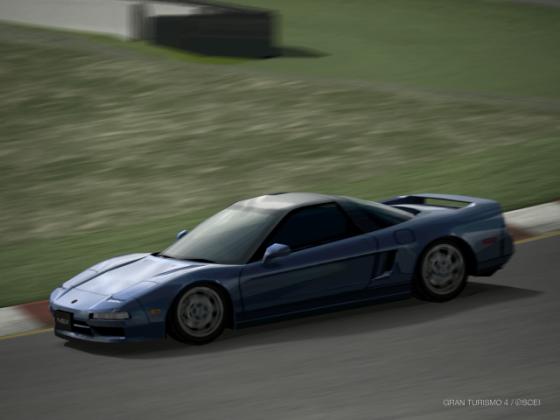
PROS-------------------------------------------------
1). One of the best-looking cars in the game. It's the Brad Pitt of
sports cars! Also, Acura/Honda hasn't slacked with their licensing availability: the Type S Zero (as well as other
NSX models) is in all four Gran Turismos.
2). Great acceleration down-low despite average torque from a small, non-turbocharged engine.
3). Any NSX will clear 170 mph around the Test Track totally stock. The Type S and Type S Zeros
makes sure we get there with room to spare via their 6-speeds.
4). All three NA upgrades available in all games, for all buyable cars (NSX,
NSX Type S, and NSX Type S Zero).
5). Flexible gearbox...most driving won't require a racing tranny, even in full racing-kit
cars.
6). A very grippy car when driven with some restraint, lots of traction, eager
to please with its handling and maneuverability...just don't push it too far.
7). The brakes are also well-suited for racing. In most cases, upgrades are optional
early on, rather than needed right away.
8). Many other upgrades (suspension, limited-slip, and tires) can also be delayed. You'll need
it all for the hardest races, though.
9). The lowish-powered V6 (for a sports car costing into the multi-thousands)
can be a detriment, yet it guarantees the car will be able to enter a wider range of races, and win many of them
easily in GT2. In other games, this lowly-powered supercar can be left stock (or nearly stock) for lots of racing, for those
who don't want a challenge.
10). Somewhat fuel-efficient (GT4). Which is a surprise.
CONS---------------------------------------------------
1). Sometimes, it seems this car has the handling dynamics of a frisbee, especially
in GT1. The GT3 and GT4 cars only get this way when pushing them to their absolute limits. The JGTC racing NSXes generally
have rock-like stability, but this assumes (at times) some tuning has been properly done.
2). No turbo. In any game other than GT1, power upgrades are downright lame...a fully-maxed Type S
Zero only possesses 172 hp more than a stock one at most. GT2, GT3, GT4: this car isn't able to take to the World
Cup, GT500, GT All Stars, etc...instead, one of the JGTC models will need to be commissioned. In GT5, the NSX is way too overpowered
for the majority of racing early on. Once we're dealing with some harder stuff (Pro League, for instance), lack of turbo upgrades
will kill this car's career, just when it's getting started.
3). Great revs & flexibility, but not
the torqueyest of engines.
4). Though the stock NSX 6-speed makes good use of the engine's narrow powerband,
it also requires a lot of shifting. Lazy folk may simply want to use an automatic, which is fine.
5). Rather expensive (not including GT4/5 used cars). In real life, we get firm but
yielding seats matched with steering that communicates plenty of road feel. We get a sporty interior, and our “I
just got laid” quota will definately be higher. In the game, we may get to drive an NSX ..but trust me, lower
lap times and competing against robot cars will NEVER get us laid!
6). Some cars in GT2 can't accept the race-mods. Again, it's time for a JGTC version when needed
to go to the top.
7). Though there are just one or two versions of the NSX Type S Zero per game, they
tend to blend in with the non-Zero versions. It's hard to tell (without looking at specs) one from the other.
8).
Rear tires burn up during those enduros, eventually causing severe tail-swinging and near-death twitchy moments.
9).
In some games, the NSX doesn't excite some of us aurally the way the real-life version does.
Originally Published: March 2006
Edited for GT4 content: October 20, 2008 Edited
for GT5 content: Really not sure when.
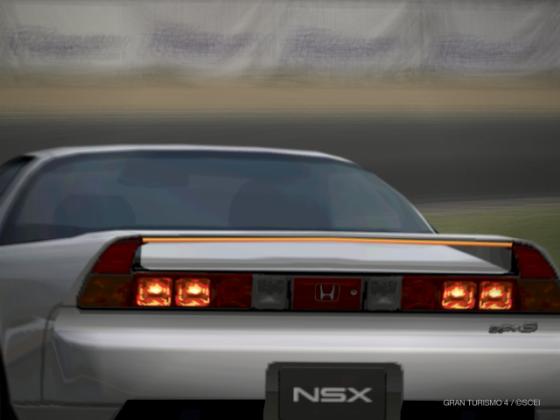
|



